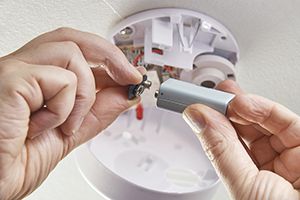 As you are “falling back” into fall with the end of daylight saving time this weekend, don’t forget to check your smoke detectors. You should always check them twice a year – once in spring and once in fall, as the time changes. Smoke detectors should be replaced every 10 years.
As you are “falling back” into fall with the end of daylight saving time this weekend, don’t forget to check your smoke detectors. You should always check them twice a year – once in spring and once in fall, as the time changes. Smoke detectors should be replaced every 10 years.
According to the National Fire Protection Association (NFPA), there were 1,342,000 fires reported in the United States during 2016 and 3,390 civilian fire deaths as a result of the fires. This data means that one civilian death occurred every two hours and 35 minutes. Fire damage added up to approximately $10.6 billion in property damage, and a fire department responded to a fire every 24 seconds.
While the sound of a smoke detector can be annoying, it is this very sound that can save your life. According to NFPA’s statistics, approximately 14,650 people are injured in fires. Many of these deaths and injuries could have been prevented with working smoke detectors. Homes should have at least one smoke alarm located on every level of the home. The NFPA actually recommends that every sleeping area has an alarm.
Here Are a Few Tips When It Comes to Smoke Detectors
- Test your detectors at least once a month by just pressing the button and making sure the alarm sounds.
- Make sure everyone in your family knows the sound of the alarm.
- Replace batteries when necessary, but it is recommended that you change them at least twice a year. An easy reminder is to change them when the time changes during daylight saving time. If you are moving into a new home, change batteries immediately.
- Never paint smoke alarms.
It is also important to create a fire escape plan for your family. Make sure everyone in the family is aware of the plan. The best plans should include at least two escape routes from every room and a designated meeting place outside the home.
Many smoke detectors now come in the form of combination smoke-and-carbon-monoxide detectors. During the heating season, opportunities for carbon monoxide poisoning increase because it is generated by your fireplace, space heater, gas stove, gas furnace and more. If you have any natural gas appliances in your home, you should have working carbon monoxide detectors near them.
Gas stoves and range tops are common sources of carbon monoxide because they are rarely vented. When purchasing an appliance, look for one with a CO safety shut-off device. Wood-burning and gas-powered fireplaces are a common source of carbon monoxide in the home, too.
Read the “Beware of carbon monoxide poisoning” blog post to understand more about the importance of having a CO detector in your home.
